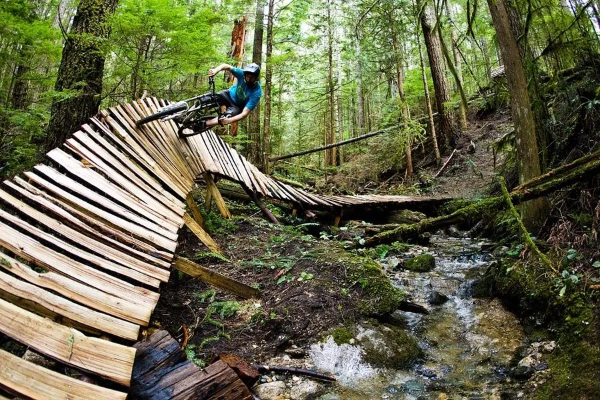Mountain biking is more than just a sport; it’s a lifestyle. Riders navigate through trails, forests, and mountains, encountering various terrains and obstacles. The thrill of overcoming these challenges is what attracts many to this sport.
The Appeal of Mountain Biking
Mountain biking offers a unique combination of physical exercise and mental relaxation. It requires strength, stamina, and a keen sense of balance. The varying landscapes and the unpredictability of the trails make it an exciting and rewarding experience.
The Community and Culture
Mountain biking has a vibrant community. Riders often share their experiences, tips, and advice. This camaraderie is one of the many reasons why people are drawn to mountain biking.
Understanding the Terrain and Jumps
Types of Terrain
Mountain biking can take place on different types of terrain, including:
- Singletrack: Narrow trails, often just wide enough for one bike.
- Downhill: Steep, technical descents.
- Cross-country: Long-distance rides over varied terrain.
- Freeride: Trails with jumps, drops, and other features designed for aerial tricks.
Types of Jumps
Jumping is a key component of mountain biking. The main types of jumps include:
- Tabletops: Jumps with a flat top.
- Doubles: Two separate take-off and landing points with a gap in between.
- Gaps: Jumps with a significant space between the take-off and landing.
- Step-ups: Jumps where the landing is higher than the take-off.
What Does “Case” Mean?
Definition of Casing
To “case” a jump means to land short, hitting the edge of the landing ramp instead of the downslope. This usually happens when a rider does not have enough speed or misjudges the distance.
Visualizing a Case
Imagine a rider approaching a jump. The ideal scenario is to land smoothly on the downslope. When a rider cases, the wheels hit the edge of the landing ramp, causing a jarring impact.
Common Causes of Casing
Inadequate Speed
One of the most common reasons for casing is not having enough speed before the jump. This can be due to:
- Misjudging the necessary speed.
- Losing speed before the take-off.
- Insufficient pedaling.
Poor Technique
Improper jumping technique can also lead to casing. This includes:
- Not lifting the front wheel enough.
- Incorrect body positioning.
- Poor timing in the take-off.
External Factors
External factors like wind, terrain conditions, and obstacles can also cause casing. Wet or loose surfaces can affect traction and speed.
Impacts of Casing on the Rider and the Bike
Physical Impact on the Rider
Casing can lead to injuries ranging from minor bruises to serious fractures. The sudden stop can throw the rider off balance, leading to falls.
Impact on the Bike
Repeated casing can damage the bike. Common issues include:
- Bent rims.
- Damaged suspension.
- Frame cracks.
Psychological Impact
Casing can also affect a rider’s confidence. Fear of casing can make a rider hesitant, which can, in turn, increase the likelihood of casing.
Techniques to Avoid Casing
Gaining the Right Speed
To avoid casing, ensure you have enough speed before the jump. This involves:
- Properly gauging the required speed.
- Maintaining momentum.
- Effective pedaling.
Perfecting Jump Technique
Improving your jump technique is crucial. Key aspects include:
- Proper body positioning.
- Timing the take-off correctly.
- Practicing lifting the front wheel.
Adjusting to External Conditions
Being aware of and adjusting to external conditions can also help prevent casing. This involves:
- Checking the terrain before jumping.
- Adjusting speed and technique based on wind and weather conditions.
Improving Your Jumping Skills
Practice Sessions
Regular practice is essential for improving your jumping skills. Set aside time to practice on different types of jumps and terrain.
Professional Coaching
Consider taking lessons from a professional coach. They can provide personalized feedback and help you improve your technique.
Analyzing Performance
Record your jumps and analyze your performance. Look for areas where you can improve and make necessary adjustments.
Training and Practice Drills
Speed Drills
Practice maintaining and gaining speed before jumps. Set up markers and practice reaching the required speed.
Technique Drills
Focus on specific aspects of your technique. This could include practicing body positioning or timing your take-off.
Simulated Conditions
Practice in different conditions to improve adaptability. This could include wet or windy conditions.
Equipment and Gear to Help Prevent Casing
Suspension Setup
Proper suspension setup can help absorb the impact of casing and reduce the risk of damage.
Tire Choice
Choosing the right tires for the terrain can improve traction and control, reducing the likelihood of casing.
Protective Gear
Wearing protective gear can minimize injuries if you do case. This includes helmets, knee pads, and body armor.
See Also: How to Gain Confidence Mountain Biking
Stories from the Trail: Real-Life Casing Experiences
Learning from Others
Reading about other riders’ experiences can provide valuable insights. Learn from their mistakes and successes.
Sharing Your Story
Sharing your own casing experiences can help other riders. It fosters a sense of community and mutual learning.
Conclusion
Understanding what it means to case in mountain biking is crucial for improving your skills and ensuring your safety. By gaining the right speed, perfecting your technique, and adjusting to external conditions, you can minimize the risk of casing. Remember, practice makes perfect, and learning from both your experiences and those of others can help you become a better rider.

